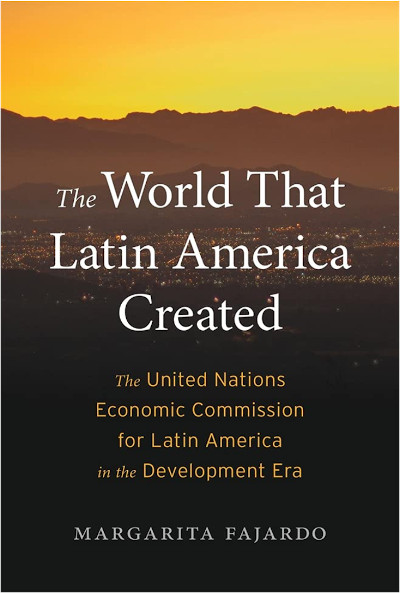In the picture
Cover of Margarita Fajardo's book 'The World That Latin America Created. The United Nations Economic Commission for Latin America in the Development Era' (Cambridge: Harvard University Press, 2022) 281 pp.
In the post-war period, Europe had the Marshall Plan and Latin America, the ECLAC. Of course, it was not the same, but when, after the war, the Latin American governments asked for international financial aid -during the conflict, the region had sent products to the countries absorbed by the war effort; now its exports and manufacturing were paralyzed-, the newly created UN finally accepted the creation of the Economic Commission for Latin America (to whose name "and the Caribbean" was later added). The United States declined sponsor something similar to the Marshall Plan, and in the end what was set up was a center at programs of study to help governments manage the Economics. The also new International Monetary Fund and World Bank, removed from the leading role played by the Marshall Plan in Europe, tried to capitalize on this initiative in Latin America, but it was soon the UN with its ECLAC that took the lead.
The book written by Margarita Fajardo explains how ECLAC was created in 1948, on what ideological assumptions it was established and how, under the guidance of the Argentine economist Raúl Prebisch, it found its own voice. It is a work for those interested in the history of economic policy, probably too exhaustive for those who only want to understand the ideological discussion in Latin America, but certainly very illustrative for that purpose.
The book's degree scroll reference letter refers to the influence that the economic thinking generated by ECLAC in Latin America had in other parts of the world; the work covers up to the 1970s and is limited to the "era of development", as indicated in the subtitle. The 1980s, with the Latin American debt crisis, aggravated by the failure of the import substitution industrialization policy sponsored by ECLAC, represents a turning point in which Fajardo no longer enters.
Today this commission, in a context of consecration of the liberal market Economics and globalization, without the doctrinal disputes of yesteryear, continues to support the work of governments with its reports, while constituting an invaluable statistical source for the economic and social sciences.
Prebisch's ECLAC, headquartered from the beginning in Santiago de Chile, soon found its groove: the theory of the center and the periphery. The 'cepalinos' were not opposed to trade between poor and industrial countries, despite the fact that the center sold high-priced finished products to the periphery, to which the latter had contributed low-cost raw materials. The 'cepalinos' were asking for the opportunity to industrialize as well, and that could only be done with foreign currency with which to buy the necessary machinery. The issue was how to overcome the gap of the lack of dollars in the periphery. There was the paradox of development: industrialization promised to reduce dependence on exports of simple raw materials, but at the same time increased the need to import industrial equipment, which required a strong currency that could only be obtained through the export of commodities. Post-war Europe was able to overcome the lack of hard currency because the Marshall Plan allowed payments in local currencies. ECLAC proposed something similar to the Bretton Woods system, but it did not succeed and, in general terms, Latin America did not get out of this vicious circle.
The theory of the center and the periphery led to an increasingly structuralism Closed, which in turn ended up in the theory of dependency, presented in Marxist terms by the most left-wing authors: there is poverty because there are rich people; it is the fault of the structure and as long as this is not changed by the revolution it will not be possible to overcome this dynamic. These parameters of thought fed the ideological struggle in the region for decades. ECLAC did not go to such extremes, but there were 'cepalinos' who distanced themselves by advocating these ideas. Some also distanced themselves by collaborating with authoritarian governments such as those of Brazil and Argentina, or with the Cuban revolution, which in reality was a great disappointment for the pioneers of ECLAC.
Time would come to endorse the more moderate positions, as Fernando Henrique Cardoso would recognize, who went from being one of the main writers of dependence to being the architect of Brazil's stabilization in the second half of the 1990s. The author of 'The World That Latin America Created' is also inclined towards this centrality; only in the final stages of its history, already marginal, does she seem to accept the terminology of the continental left when she calls the reforms that, around the turn of the century, had to be applied in the region to establish macroeconomic equilibrium and which allowed the growth that followed, a "neoliberal offensive".

